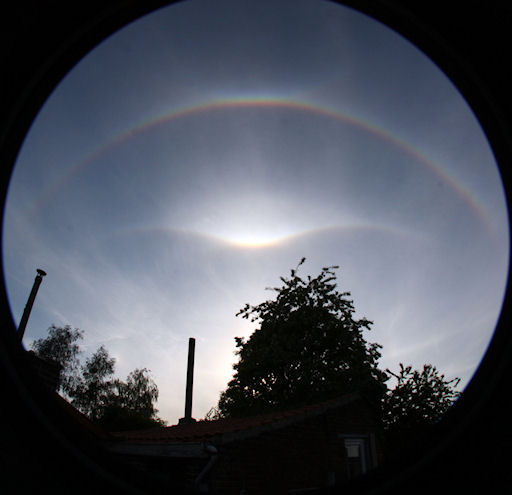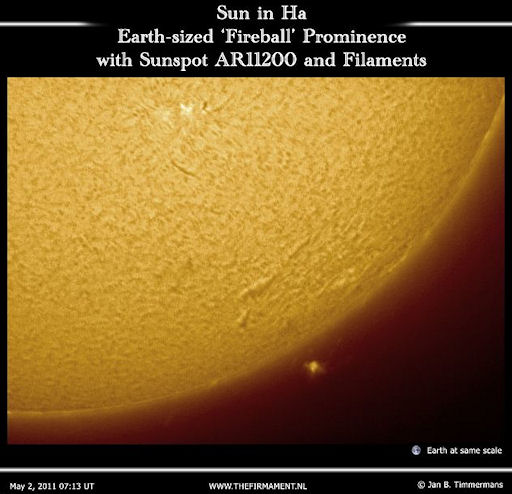Are we alone? Your iPhone has the answer. Download the all-new Drake Equation app to calculate the population of the Milky Way. | | |
FIREBALLS FROM HALLEY'S COMET: NASA's network of all-sky cameras in the southeastern United States detected a surplus of fireballs on May 7th. The bright meteors came from Halley's Comet, source of the annual eta Aquarid meteor shower. Movies of the fireballs may be found here. According to counts from the International Meteor Organization, Earth is still inside the Halley debris stream, so more fireballs might be in tthe offing tonight. Stay tuned.
SUN HALOES: Yesterday in Belgium, sky watchers were stunned when they witnessed a heavenly apparition in broad daylight. "It was one of the brightest and most complex displays of sun haloes I have seen in 25 years of observing," reports Philippe Mollet, who took this picture:

image with labels | more images
"The phenomenon lasted for more than 30 minutes, long enough to phone and e-mail many friends and colleagues," he adds. "[It looks like] this was observed over a large part of our (little) country."
Sun haloes are caused by ice crystals in high clouds. "This wonderfully bright display proves that you do not need to be in polar regions to see them," notes atmospheric optics expert Les Cowley. "Temperatures in 3 to 6 mile high cirrus are more than cold enough to make the needed hexagonal prism shaped ice crystals. There are two sets of halos, those nearest the sun are made by rays that pass between crystal faces inclined at 60 degrees. The outer halos with widely separated colors are from faces inclined at 90 degrees. See the labeled image for halo names. The huge colourful halo is a supralateral arc. This halo is often very hard to distinguish from the much less common 46 degree circular halo but there are several clues to look for to tell them apart."
more images: from Hendrik Mertens of Londerzeel, Belgium
A FIREBALL THE SIZE OF EARTH: "When the sun rose on May 2nd, I was surprised to see a fully detached fireball prominence at the southwestern edge of the solar disk," reports amateur astronomer Jan Timmermans of Valkenswaard, The Netherlands. "Just imagine, a ball of fire with the size of the Earth thrown high in the solar skies!"

"I was stunned," he continues. "The prominence was rather faint, so I had to use a lot of gain to capture it, hence the noise: 'more gain = more grain.' But I am pleased that I captured it!"
more sun-shots: from Stephen W. Ramsden of Atlanta, Georgia; from John Minnerath of Crowheart, Wyoming; from Lyle Anderson of Duluth, Minnesota
April 2011 Aurora Gallery
[previous Aprils: 2010, 2009, 2008, 2007, 2006, 2005, 2004, 2003, 2002]

